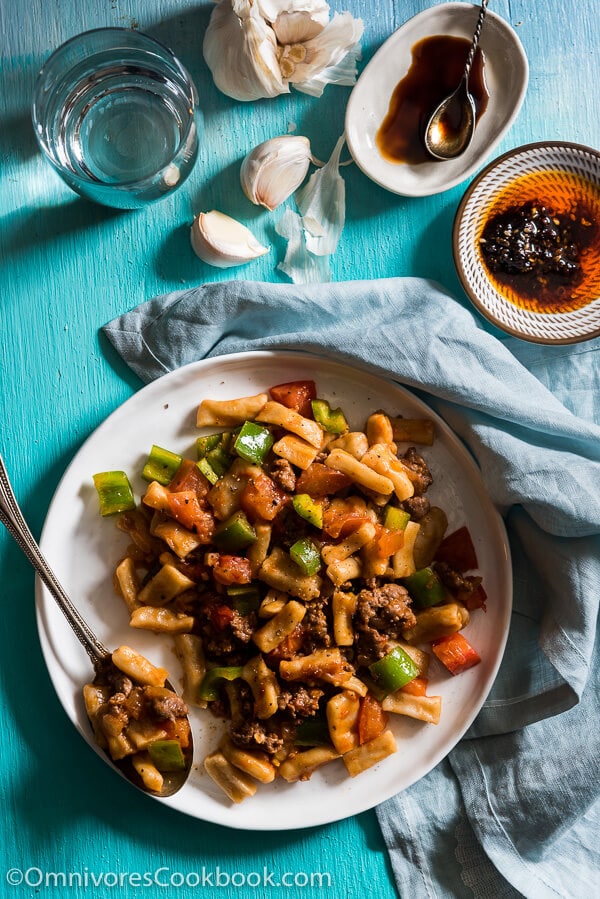
Ding Ding Chao Mian (丁丁炒面) is a signature dish from Xinjiang. The region is located in the far west of China, adjacent to Kazakhstan and Mongolia. The majority of the population is Uyghur (a Turkic ethnic group), and their food is highly influenced by central Asian cuisine, as well as traditional Chinese cuisine.
Xinjiang food is wildly popular in Beijing and we’ve been eating it we were growing up. Some of our favorite dishes are roast lamb skewers (Chinese kebabs), Baked samosa (A bread with savory filling), and Ding Ding Chao Mian.
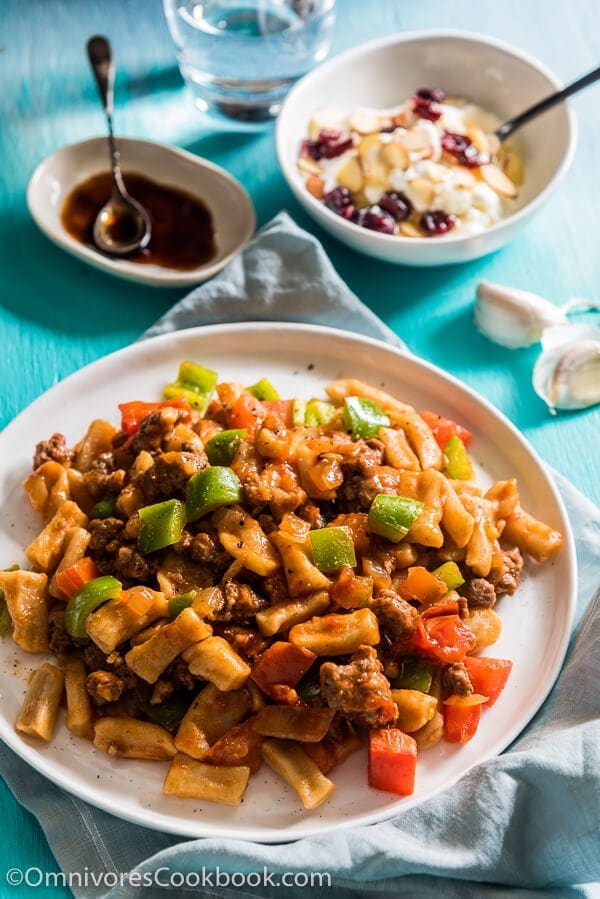
Craving fresh noodles
Fresh handmade noodles are a luxury in the US. Back in China, they’re one of the cheapest foods you can get. Even in big cities like Beijing, you can easily find small diners serving handmade noodle dishes at 2 to 3 dollars a bowl.
After eating fresh noodles for years, I’ve gotten picky about my noodles. That’s one of the reasons I feel reluctant to cook with dried noodles. They just don’t taste right. I miss the days when I could get fresh noodles for 50 cents a pound from our next-door vegetable market.
I admit, it’s a bit too obsessive to make noodles from scratch just to cook a plate of fried noodles. But in order to present this dish the authentic way, freshly made noodles were a must.
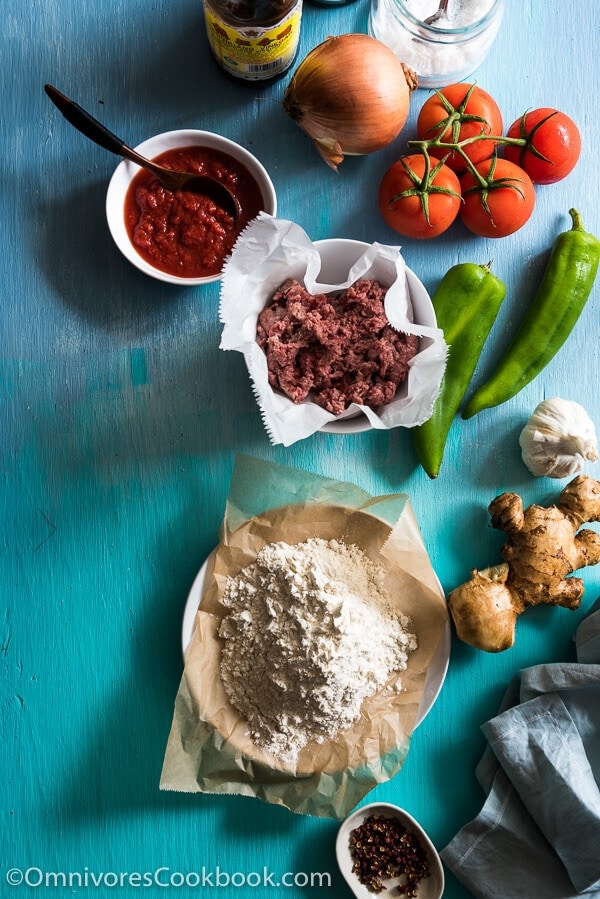
Some of you might have heard of Ding Ding Chao Mian before. For these who haven’t, you might wonder why I call these small pieces of dough “noodles” instead of gnocchi. I promise I didn’t make this up. We do have this type of noodle in China, and they’re shaped pretty similarly to gnocchi. They are freshly made from wheat flour (no potato) and have a very meaty texture.
These short noodles are another form of hand pulled noodles. Instead of pulling the noodles into long thin strips, you leave the noodles thick, and cut them into small chunks. It results in a firmer shape and chewier texture. The short noodles soak up sauce nicely and keep their shape well. Perfect for stir frying.
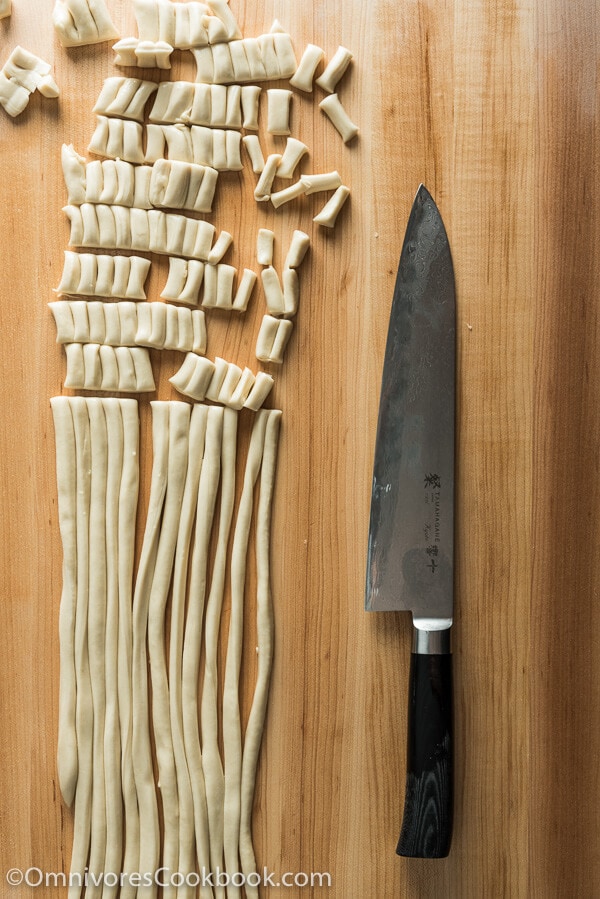
Cooking notes
Do not let the handmade noodles scare you away from this recipe! You can use any type of noodle to cook Ding Ding Chao Mian, even dried.
I recommend you use fresh wide noodles if you can find them. Simply chop the noodles into shorter pieces before boiling them, and you’ll have a dish very close to the original one. My other recommendations are Farfalloni and Rotini pasta. They will save you the trouble of chopping. Their texture is firm and very close to the original dish.
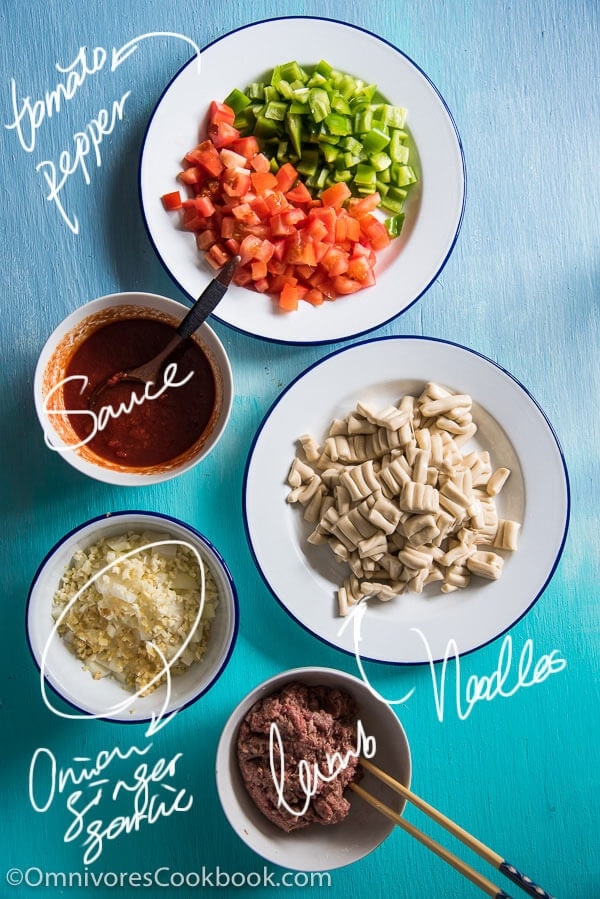
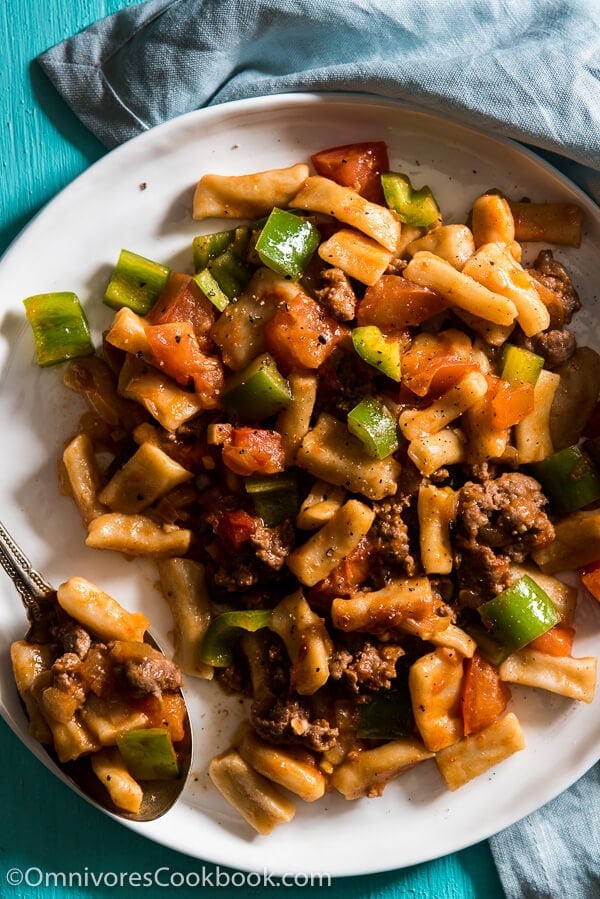
For those who want to challenge themselves with a real-deal Ding Ding Chao Mian, try making the noodles once and you’ll find it easier than you thought. If you have a KitchenAid stand mixer, I highly recommend you use it to knead the dough. It saves you time, allows the water to incorporate more thoroughly, and produces a dough that is easy to pull.
A Xinjiang housewife who is familiar with the process can probably get the whole dish done in 45 minutes, from making the noodles by hand to finishing the stir-fry. I can’t. But I did manage to finish the whole thing in an hour. It could be a fun weekend project for you to challenge yourself with. And the results are very rewarding.
If you’re not making the noodles from scratch, you can finish prep and cooking in 20 minutes. A great option for a quick weekday dinner.
I adapted the recipe from the Ding Ding Chao Mian by the famous Chinese blogger Wen Yi. She is married to a Xinjiang guy and has learned a lot of secrets to create the authentic flavor. When I’m looking for a Xinjiang recipe, I go to her blog first to make sure I’m doing everything right. You can’t go wrong when you’ve learned from the best 🙂
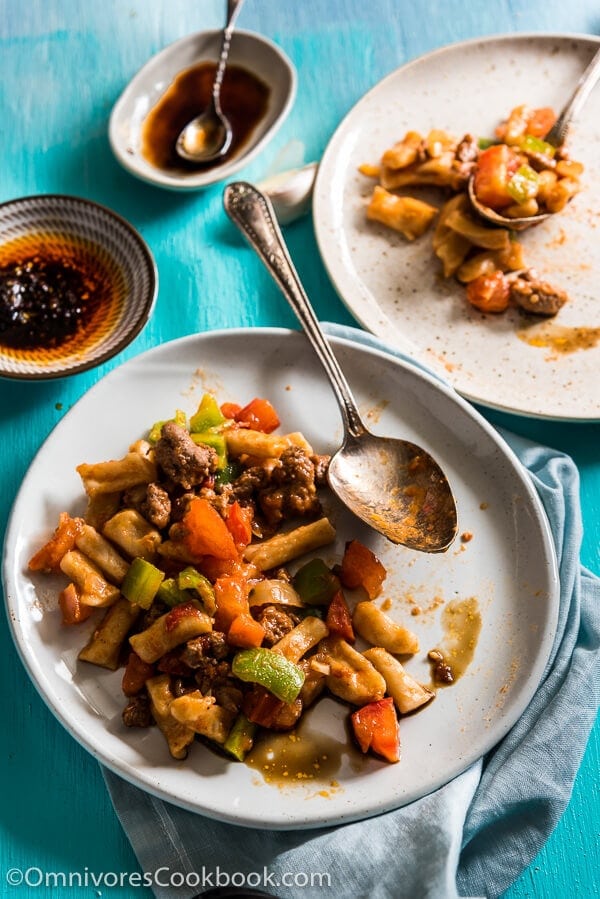
Do you like my recipes? Sign up our weekly newsletter to get the latest updates delivered to your inbox and a FREE e-cookbook that contains my top 30 most popular recipes!
Chinese Cooking Made Easy
Are you new to this website? This free email series is a great place to start. I’ll walk you through a few of my most popular recipes and show you how and why they work. You’ll quickly start to cook better Chinese food in your own kitchen.
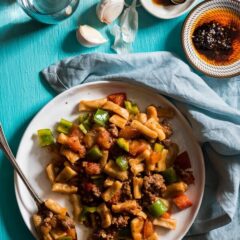
Ding Ding Chao Mian (丁丁炒面, Fried Noodles in Lamb Tomato Sauce)
Ingredients
Noodles (See footnote 1)
- 300 grams all-purpose flour convert to cups
- 1/8 teaspoon salt
- 3/4 cup (180 grams) warm water (See footnote 2)
Marinade
- 1/2 pound (200 grams) ground lamb (or lamb leg meat, cubed) (See footnote 3)
- 2 tablespoons Shaoxing wine
- 1/4 teaspoon Sichuan peppercorn , grounded (or ground black pepper)
- 1 teaspoon salt
- 1 teaspoon potato starch (or cornstarch)
Sauce (*see footnote 4)
- 1/2 cup tomato sauce (*see footnote 5)
- 2 tablespoons soy sauce (or light soy sauce)
- 1 teaspoon sugar
- 1/4 teaspoon salt
- 2 tablespoons vegetable oil
- 1/2 onion , chopped
- 4 garlic , minced
- 2 pieces ginger , minced
- 1 to mato , cubed
- 2 anaheim peppers (or 1 bell pepper, or 2 jalapenos, diced)
- 2 tablespoons black vinegar
Instructions
Make noodles
- Prepare mixer. Attach the beater blade. Combine flour and salt in the mixing bowl. Turn to low speed. Slowly add water. Let mix until it forms a dough. Change to dough hook. Turn on slow speed and let knead until the dough is very smooth, about 10 minutes. If you’re not using a KitchenAid mixer, start by mixing the flour with the water, stirring with a spatula, until the dough forms. Dust a working surface with flour and transfer the dough onto it. Knead until the surface becomes smooth, about 15 minutes.
- Spray a thin layer of oil onto the bottom of a large bowl. Place the dough inside. Cover with plastic wrap. Let rest at room temperature for 20 minutes.
- While resting the dough, marinate the lamb and chop the veggies.
- When the dough has rested, prepare a large cutting board (or working surface). Brush a thin layer of oil in the middle. Place the dough on top. Press it into a 1-cm (1/3-inch) sheet with your hands.
- Brush oil on top of the dough. Cover loosely with plastic wrap and let rest for 10 minutes.
- Bring a large pot of water to a boil.
- Make sure your working surface is covered with a thin layer of oil.
- Slice the dough sheet into 10 to 12 strips. Make sure you leave enough space in between them, to prevent them from sticking together.
- Work on the strips one by one. Use both hands to pull the strip into a 5-mm (1/4-inch) wide noodle.
- Brush a thin layer of oil onto the noodles to prevent them from sticking.
- Gather the noodles together again. Cut into 1-cm (1/3-inch) long pieces. The noodles may stick together at this point, but will separate during boiling.
- Add the noodles into the boiling water right after you cut them. Immediately stir with a spatula to separate the noodles. Let cook until the noodles are floating on top. Continue cooking for 2 to 3 minutes, until the noodles are almost cooked through.
- Drain the noodles and rinse them with tap water, to stop the cooking.
Marinate lamb
- Combine ground lamb (or cubed lamb leg), Shaoxing wine, salt, Sichuan peppercorn, and potato starch in a small bowl. Mix well. Let marinate for 10 to 15 minutes.
Make sauce
- Combine tomato sauce, light soy sauce, black vinegar, sugar, and salt in a small bowl. Set aside.
- Heat oil over medium high heat until hot. Add onion, garlic, and ginger. Cook until the onion turns slightly golden, 2 to 3 minutes.
- Use the spatula to move everything to one side of the pan. Add ground lamb onto the other side. Spread the lamb to let the bottom brown slightly. Stir until the surface is cooked.
- Mix everything together. Add the tomato sauce mixture. Stir to mix well.
- Pour the drained noodles into the skillet. Stir to mix well. Adjust seasoning if necessary. If the noodles are still a bit raw inside, cover and let steam for a minute or so, until cooked through.
- Add tomato and anaheim pepper. Stir a few times to gently cook the veggies.
- Transfer to plates and serve immediately.
- (Optional) Pour a spoonful of black vinegar onto your noodles before eating, just like real Xinjiang people do.
Notes
- You can use Chinese noodles (the wide type), Farfalloni or Rotini to make this dish as well. If you use Chinese noodles, chop them into 5-cm (2-inch) pieces and boil them until al dente.
- I used hot water from the tap, about 50 degrees C (120 to 130 F).
- You can use other ground meat too, such as chicken or beef. Most Xinjiang dishes are halal. To keep the dish authentic, stay away from pork.
- The original dish only uses the minimum amount of sauce as a seasoning. I have increased the sauce, but the amount is still moderate. If you like lots of sauce, skip the salt and double the sauce given here. You can adjust seasoning at the end of the cooking.
- I used Muir Glen arabella select plum tomatoes sauce, which have a bright and fresh flavor. Alternatively, you can use 3 tablespoons tomato paste with 3 tablespoons water.
Have a question or feedback? Add a Comment
Did you make this? I want to see! Tag @OmnivoresCookbook on Instagram, and rate the recipe below.


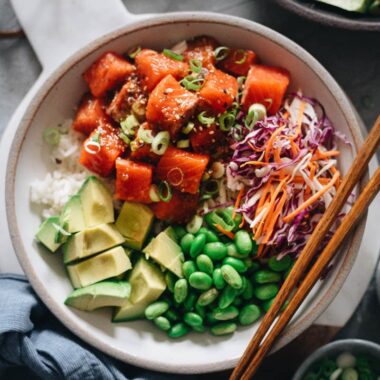

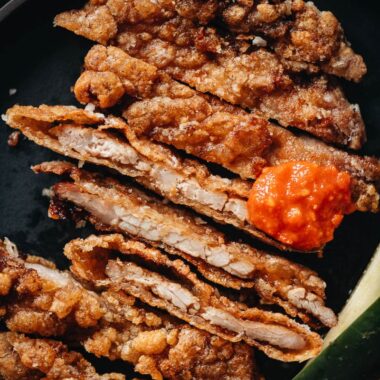
Kp
I actually used this recipe sans the noodles as a tamale filling over the Dia de los Muertos holiday. It was a hit. 🙂
K
This was so good! I used dried noodles and it was amazing. I’m sure fresh noodles are even better. My husband and I ate almost the entire batch. Sooooo good. Thanks for sharing!
Maggie Zhu
I’m so happy to hear you made this one and liked it! Yeah it’s nice to have fresh noodles, but dried noodles are so convenient and nothing can beat that on a busy weekday. Good to know the dried noodles worked out alright 🙂
K
Maggie-
How much dried noodles would you use? I’d like to try this out soon.
Thanks for your wonderful recipes.
K
Poor Guy :(
I used a few dash of whiskey instead of Shaoxing wine and it was good.
Kernan
Excited to make this. Is the Black Vinegar another name for Zhen Jiang vinegar?
Maggie Zhu
Yes! Happy cooking 🙂
雨新
Hi! I’m really interested in xinjiang food. Can you link to Wen Yi’s blog you mentioned? I tried to look it up but I couldn’t find it. I can read Chinese if the blog is in Chinese. Thank you!
Maggie
Her blog is: http://blog.sina.com.cn/wenyi
She has so many beautiful recipes!
Tiffany Butt
Hi, can you make the dough in advance, like in the morning? Also, have you tried using whole wheat flour instead of all-purpose? Thanks so much! Also am going to try making this with the carrot dumplings, the four-ingredient Okra and the tomato-shrimp stir fry!! 😀
Maggie
Hi Tiffany, yes you can make the dough in advance. It will get tenderer if you rest it longer, so it will become very easy to pull.
No I have not tried using whole wheat flour yet. I’d be cautious about it, because the dough might not stretchy enough to pull apart. I’d like to try it out and keep you updated on this.
Wow, you’re making quite a few dishes! Are you cooking for a party?
Happy cooking and hope everything turns out great 🙂
Kevin | Keviniscooking
I’m not afraid, this looks outstanding. Love getting caught up on everyone’s posts while I was away. 🙂 Pinned, need to try this one!
Eha
This is my first visit to your site and I am absolutely thrilled to find a recipe from an area of China about which I know little. Being a European-born Australian ‘Chinese’ is naturally often on the menu but my knowledge is largely limited to my favourite Szechwan, Shanghainese, Hainanese and the fusion Nonya methodologies’. Love lamb, am not afraid of making my own noodles and cannot wait to try as your sauce ingredients also vary from most I use. Please some more such-like, Maggie 🙂 !
Maggie
Thanks for taking time and leaving such a nice comment Eha! I’m so happy to hear you like this recipe. I was very hesitated to talking about this dish, because it is so unfamiliar outside of China. As for these familiar dishes, I love them too. But there are so many more good food to be discovered. I’d love to keep sharing more less-known recipes.
Happy Cooking Eha! And please let me know how the cooking turns out 🙂
Michelle @ Vitamin Sunshine
This looks delicious Maggie– and yes, a good weekend challenge. I have a few Mexican food bloggers who I go to when I want to make my American Tex-Mex a little more authentic 🙂 It’s good to have those you know you can rely on.
Maggie
Thanks Michelle! Yes, it’s definitely helpful if you can learn from the locals. To speak of Tex-Mex, I’ve been cooking it a lot lately, since it’s so easy to get fresh ingredients here in Austin. I’m very happy about it 🙂
Hope you have a wonderful weekend Michelle!
Helen @ Scrummy Lane
Every time I read one of your posts I think how lucky your husband is to have you cooking up these amazing authentic dishes.
I enjoyed reading this one so much that I’m going to post it on my Facebook page.
Is this dish or similar ever made with other meats like beef or chicken?
Love the sound of those fresh noodles too. I think I could possibly make them in my breadmaker on the dough setting! 🙂
Maggie
I wish you live next door Helen, so we can share the food! The dish will still be very tasty if making with beef or chicken. I think beef will work a bit better, since it contains a bit more fat. You can definitely make the dough by using breadmaker. It’s not something I do all the time, but it’s great to have fresh noodles once in a while!
Hope you have a wonderful weekend Helen 🙂
Bam’s Kitchen
I can imagine the chewy and delicious texture of your home made noodles and can’t wait to give this recipe a try. Nothing beats the love that goes into homemade noodles and lamb sauce. I could not agree with Kathleen more… you are spoiling Thomas rotten with all of your delicious dishes. Love this dish!
Maggie
I bet you’ll love this dish Bobbi. But don’t be too obsessed with the fresh noodles lol You can cook this really quick if you buy noodles instead. I believe it’s easier to get great noodles in Hong Kong.
Hope you have a great weekend Bobbi 🙂
Kathleen | Hapa Nom Nom
Hand-pulled noodles, that are left fat and chewy to soak up the sauce??? Omg, Maggie – you tell your husband he’s the luckiest man on earth! Can you guys just adopt me please? 😛
Maggie
I just told Thomas to read comment, so, message well received 😉
I wish you live next door Kathleen, so we can have dinner party everyday!